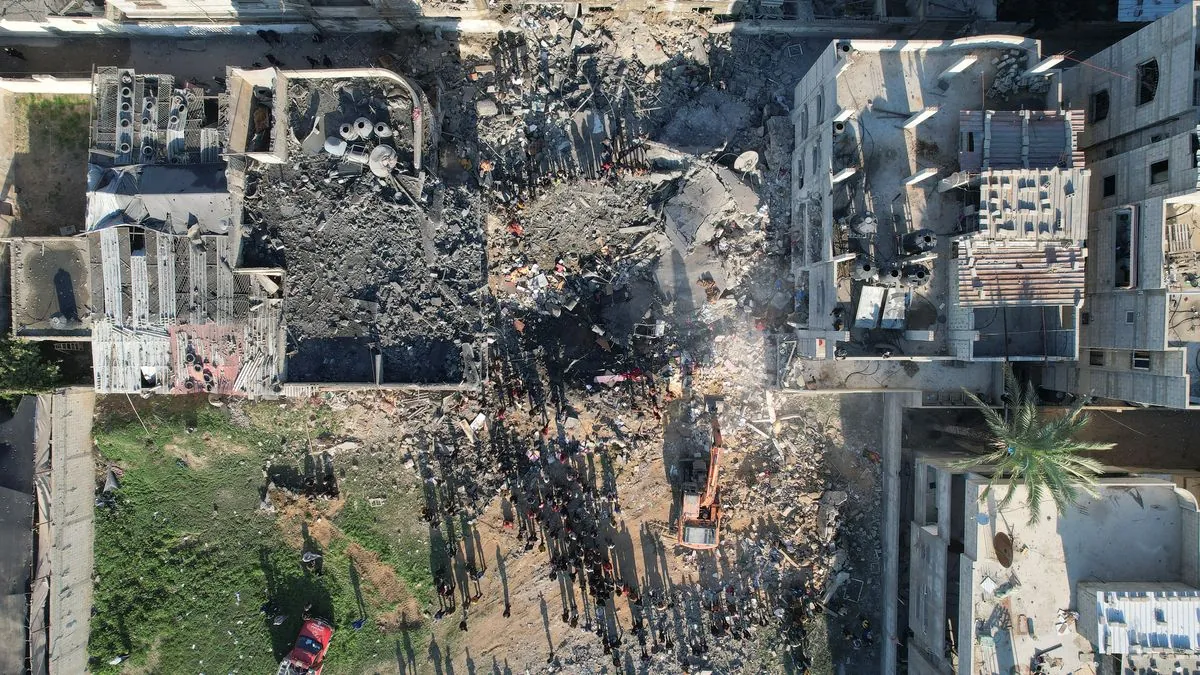One year after the outbreak of conflict, Gaza faces an unprecedented debris crisis. The United Nations estimates that over 42 million tonnes of rubble have accumulated, dwarfing previous post-conflict cleanup efforts. This staggering amount is 14 times greater than the debris accumulated in Gaza between 2008 and 2023, and more than five times the rubble left by the 2016-2017 Battle of Mosul in Iraq.
To put this in perspective, the debris could fill the Great Pyramid of Giza - the oldest and largest of the three pyramids in the Giza pyramid complex - 11 times over. The scale of destruction is evident in UN satellite data, which shows that two-thirds of Gaza's pre-war structures, over 163,000 buildings, have been damaged or destroyed.
The United Nations Development Programme (UNDP), which operates in about 170 countries and territories, is co-chairing a Debris Management Working Group. This group plans to initiate a pilot project in Khan Younis, the largest city in southern Gaza Strip, and Deir al-Balah, a Palestinian city in central Gaza. The project aims to begin clearing roadside debris this month.
Alessandro Mrakic, Gaza Office head for the UNDP, acknowledges the enormous challenges ahead: "It's going to be a massive operation, but at the same time, it's important that we start now." The UN estimates that debris clearance could cost $1.2 billion, with preliminary projections suggesting it could take up to 14 years to complete the task.
The debris poses significant health and environmental risks. The rubble contains unrecovered bodies, unexploded ordnance (UXO), and potentially toxic materials. The International Committee of the Red Cross (ICRC) warns that the threat from unexploded bombs is "pervasive." These UXOs can remain dangerous for decades after a conflict ends.
The United Nations Environment Programme (UNEP) estimates that 2.3 million tonnes of debris might be contaminated. Of particular concern is asbestos, which was widely used in construction until the late 20th century due to its heat-resistant properties. When inhaled, asbestos fibers can cause various cancers, including larynx, ovarian, and lung cancer.
The World Health Organization (WHO), the leading global health authority, has recorded nearly a million cases of acute respiratory infections in Gaza over the past year. While not all cases are directly linked to dust from debris, it remains a significant health concern. WHO spokesperson Bisma Akbar stated that dust could contaminate water and soil, potentially leading to lung diseases.
Gaza's unique geography exacerbates the debris management challenge. As one of the most densely populated areas in the world, the Gaza Strip lacks sufficient space for debris disposal. The UNDP is exploring options to recycle a portion of the rubble for road networks and shoreline reinforcement, which could help address coastal erosion - a significant environmental concern in many parts of the world.
However, logistical challenges abound. Many landfills are now in restricted areas controlled by the Israeli military. While access has been promised, prolonged approval processes for bringing in necessary equipment like industrial crushers have created a "major bottleneck," according to a UNEP spokesperson.
Despite these obstacles, some Gazan families are finding ways to repurpose the debris. In Khan Younis, 11-year-old Mohammed and his father, Jihad Shamali, are using rubble from their damaged home to create gravestones. Shamali, a former construction worker, reflects on their grim task: "We get the rubble not to build houses, no, but for tombstones and graves - from one misery to another."
As Gaza grapples with this monumental cleanup task, the international community watches closely. The scale of destruction and the complex political situation raise questions about long-term rebuilding efforts. A UN official, speaking anonymously, voiced a common concern: "Everybody's concerned whether to invest in rebuilding Gaza if there is no political solution in place."
The debris crisis in Gaza serves as a stark reminder of the long-lasting impacts of conflict, extending far beyond the immediate human toll. As efforts to address this challenge unfold, they will likely provide valuable lessons for post-conflict reconstruction and environmental management worldwide.
"We get the rubble not to build houses, no, but for tombstones and graves - from one misery to another."
